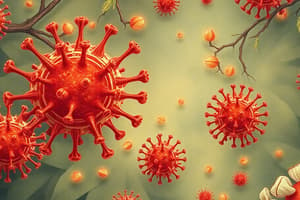Podcast
Questions and Answers
What is one crucial life process that refers to how molecules move around within living systems and between them?
What is one crucial life process that refers to how molecules move around within living systems and between them?
- Osmosis
- Transportation (correct)
- Cell division
- Photosynthesis
Which process allows small molecules like oxygen and carbon dioxide to flow through lipid membranes?
Which process allows small molecules like oxygen and carbon dioxide to flow through lipid membranes?
- Passive diffusion (correct)
- Endocytosis
- Active transport
- Facilitated diffusion
What specialized method is responsible for moving larger particles across the cell membrane?
What specialized method is responsible for moving larger particles across the cell membrane?
- Facilitated diffusion
- Passive diffusion
- Endocytosis
- Active transport (correct)
Which organelle movement promotes photosynthesis efficiency during the day?
Which organelle movement promotes photosynthesis efficiency during the day?
What type of motion enables cells to optimize their functions by rearranging components according to demands?
What type of motion enables cells to optimize their functions by rearranging components according to demands?
Which transportation process involves vesicles shuttling biomolecules between organelles in a cell?
Which transportation process involves vesicles shuttling biomolecules between organelles in a cell?
What is one way that information and materials are exchanged across cell boundaries?
What is one way that information and materials are exchanged across cell boundaries?
Which of the following is a function of gap junctions in cell communication?
Which of the following is a function of gap junctions in cell communication?
What role do hormones, neurotransmitters, and other signaling molecules play in influencing neighboring cell activity patterns?
What role do hormones, neurotransmitters, and other signaling molecules play in influencing neighboring cell activity patterns?
Which of the following is an example of efficient transportation mechanisms in tissues?
Which of the following is an example of efficient transportation mechanisms in tissues?
During developmental stages, how do cells usually migrate to reach appropriate destinations?
During developmental stages, how do cells usually migrate to reach appropriate destinations?
In summary, what enables survival and adaptation against daunting odds in life processes?
In summary, what enables survival and adaptation against daunting odds in life processes?
Flashcards are hidden until you start studying
Study Notes
Life's Motion: Understanding Transportation Processes
Life is a whirlwind of interconnected activities and movements — from molecular interactions to organism behavior. Transportation, one crucial life process, refers to how molecules move around within living systems and between them, ensuring proper functioning amidst constant change. To appreciate the role of transportation in maintaining life's dynamic balance, let's examine some essential aspects.
Cellular Transportation
At the heartbeat of all life lies the cell, with its numerous transport mechanisms enabling nutrient uptake and waste expulsion while safeguarding the cell's internal environment. Passive diffusion allows small molecules like oxygen and carbon dioxide to flow through lipid membranes, but larger particles require more specialized methods such as osmosis, facilitated diffusion via carrier proteins, and active transport using energy derived from ATP hydrolysis.
Organelles & Intracellular Structure
Organelle mobility enables cells to optimize their functions by rearranging components according to demands. For example, chloroplast movement during the day promotes photosynthesis efficiency, whereas mitochondria relocation enhances energy production. These intricate motions also facilitate communication among various parts of the cell. As an illustration, vesicles shuttle biomolecules between organelles, thereby coordinating cellular responses.
Intercellular Communication & Movement
The exchange of information and materials across cell boundaries occurs both through direct contact and indirect signaling pathways involving chemical messengers. The formation and dissolution of gap junctions allow electrons, ions, and small molecules to pass directly between adjacent cells, contributing to tissue homeostasis. Furthermore, hormones, neurotransmitters, and other signaling molecules influence neighboring cell activity patterns, promoting collective behaviors and adaptations within tissues, organs, and multicellular communities.
Tissue Organization & Development
Together, cells form functional units called tissues, which cooperate through specific types of transportation. For instance, a vital human function supported by this cooperation includes blood circulation, where red blood cells distribute oxygen throughout the body, while platelets promote clotting when vessels rupture. Other examples involve specialized structures such as glands, muscles, connective tissue, and nervous systems, whose organization necessitates efficient transportation mechanisms. Moreover, during developmental stages, cells migrate along well-defined routes to reach appropriate destinations, guided by complex extracellular signals and intrinsic properties.
In summary, life processes encompass a myriad of transportation phenomena that enable survival and adaptation. By understanding these fundamental dynamics, we can delve deeper into why life persists against such daunting odds.
Studying That Suits You
Use AI to generate personalized quizzes and flashcards to suit your learning preferences.




